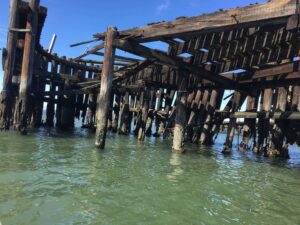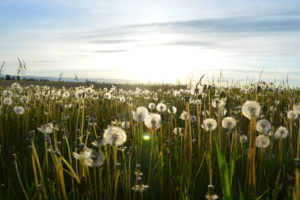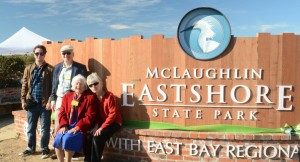At a January 2006 meeting, the East Bay Regional Park District (EBRPD) Board of Directors approved the Land Use Plan Amendment for Robert Sibley Volcanic Regional Preserve after first removing the plan’s controversial campground provision. The board received volumes of written comments prior to the meeting and heard spoken comments from many individuals and representatives of Bay Area environmental and recreation organizations during the public hearing portion of the meeting.
The majority of the presenters, including representatives of the Sierra Club San Francisco Bay Chapter, California Native Plant Society East Bay Chapter, Golden Gate Audubon Society, and Regional Parks Association, as well as a number of individuals, opposed the campground provision. Speakers questioned the impact of a large camping facility on the movement of animals through the Caldecott Wildlife Corridor, expressed concern about the increased risk of wildfire in an already hazardous area, noted the vegetation value of the quarry site, questioned the general suitability and attractiveness of this location for a campground, and suggested that the impacts of the campground would constitute a major development and as such would require preparation of a full Environmental Impact Report.
Representatives and members of the Bay Area Bicycle Coalition, Bicycle Trails Council East Bay, Roughing It Day Camp, EBPRD Camping Task Force, and Alameda Boys and Girls Club commented in favor of the Land Use Plan Amendment, supporting the provision allowing bicycle access to the Skyline Trail in Sibley Preserve as well as the campground proposal.
At the end of the discussion, the directors deleted the campground provision from the Land Use Plan Amendment in a 4-to-3 vote and then unanimously approved the plan and the associated Mitigated Negative Declaration. More than one director noted that the presentations and written comments influenced their thinking and votes on the campground issue.
Sue Rosenthal
Previous Update (4/22/05)
Although Round Top lies dormant today, the East Bay Regional Park District is busy putting out fires of its own. In response to District land-use planning documents for Sibley Volcanic Regional Preserve released in November and December of 2004, the California Native Plant Society (CNPS) and the Sierra Club have taken issue with the District’s plans to develop a 300-person group camp site and additional parking and staging areas.
The District is in the midst of restoration efforts to clear, fill, and curb erosion in a former quarry pit on the Stone Property, an area next to the Preserve that is slated to be open to the public in the near future. The proposed Mudstone Recreation Unit Group Camp would be sited in the restored quarry. Envisioned by the Park District as a camp facility where scout jamborees, church groups, and environmental science classes can congregate, Mudstone would include parking for 60 cars and the requisite restrooms, picnic tables, and BBQs. The District has also proposed expanding the existing Skyline Staging Area to accommodate approximately 40 cars, developing a new staging area for some 20 cars off Old Tunnel Road (which would be improved), and a new Quarry Staging Area for some 30 cars accessible off of existing haul roads.
In its official documents, the District determined that “although the proposed project could have a significant effect on the environment, there will not be a significant effect in this case because revisions in the project and mitigation measures have reduced all impacts to an insignificant level.” A finding of no significant impact means the Park District is not required to prepare an Environmental Impact Report.
But CNPS and the Sierra Club don’t agree. They are especially concerned about the potential impacts an increase in trail and road traffic might have on the Caldecott Wildlife Corridor, a portion of which runs through Sibley. This corridor provides connectivity along the Oakland/Berkeley Hills between the Preserve and Oakland’s Grizzly Peak Open Space, allowing sufficient habitat for wide-ranging species such as foxes, deer, coyotes, and mountain lions.
Norman La Force of the Sierra Club’s San Francisco Bay chapter has raised concerns about the placement of campsites, roads, and trails adjacent to riparian corridors. The CNPS, in its letter to the District, also cites an increased likelihood of wildland fires due to fire pits, and questions the impact that more visitors might have on rare and unusual plant species, the local fauna, and the cultural and geologic resources on this property, which has been off-limits to the public since it was acquired in 1992.
Both the CNPS and the Sierra Club question whether the recreational activities proposed for the Mudstone Unit are in keeping with Sibley’s designation as a “preserve” rather than a “park.” But retired District Assistant General Manager Tom Mikkelsen, who conducted a review of the District’s Camping Program, points out that the Park District’s revised 1997 “Master Plan” is a guideline, with “no hard-and-fast definitions.” Among other minimum standards, these guidelines loosely define a Regional Park as being able to accommodate a variety of recreational activities which “may not take place in more than 30 percent of its area,” whereas recreational activities in a Regional Preserve “will comprise no more than five percent of the area.”
Both Mikkelsen and District Chief of Planning and Stewardship Brian Wiese assert that despite the controversy, recreational uses in the Preserve would occupy considerably less than the recommended five percent. According to Wiese, the Park District calculates that the existing and proposed recreation plans together would cover some 5.85 acres, or 0.9 percent, of the approximately 660-acre preserve.
Nonetheless, Mikkelsen said that the Park District board of directors and staff “will take to heart” the public’s concerns. “If there are things to change, the plan will be recast to address these issues,” Mikkelsen said. The Park District hopes to have a response to comments by mid-summer.
A public hearing to address the Sibley Volcanic Regional Preserve Land Use Plan Amendment, scheduled for February 1, 2005, was postponed, and a new meeting date has yet to be announced; check the Park District’s public hearing calendar for details. More information about the proposed recreational facilities at Sibley, including the draft Land Use Plan Amendment, Initial Study, and Proposed Mitigated Negative Declaration, can be viewed at the Park District’s website. If you are interested in helping shape the future of Sibley, contact the Park District, the East Bay Chapter of CNPS, or the Bay chapter of the Sierra Club.
– Matthew Bettelheim




